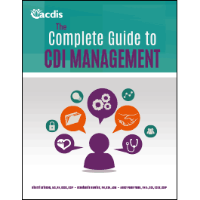Book excerpt: Spreading the mission of CDI

to CDI Management
By Cheryl Ericson, MS, RN, CCDS, CDIP, Stephanie Hawley, RN, BSN, ACM, and Anny Pang Yuen, RHIA, CCS, CCDS, CDIP
A crucial part of building a successful CDI department is making its mission known within the whole organization. Once the mission is established, share it. While each department within an organization has its own role and its own individual mission, departments like HIM, utilization management, and quality should understand what the CDI department’s role is. Collaboration will allow all the departments to work toward a common goal of complete and accurate documentation that reflects the complexity of the clinical scenario. Most importantly, the administration should have an understanding of the mission so organizational expectations are aligned with daily duties.
CDI specialists are often visible on the medical units, but the floor staff can be unsure of their role. It is important for the CDI staff to develop a relationship with the unit staff, because they can then support CDI efforts. This can include informing the provider of the presence of a query and/or informing CDI staff when a patient’s condition has deteriorated or additional documentation is available.
The relationship between utilization review (UR) and CDI is important, because the UR staff are integral in determining a patient’s status. Traditionally, CDI reviews focus on the inpatient setting, so a strong relationship with UR keeps CDI informed when patient status changes occur. The movement of an inpatient to an outpatient, or from an outpatient to an inpatient, can affect CDI. Conversely, if a patient moves from outpatient to inpatient, the CDI review may need to be expedited because the patient may be closer to discharge since evaluation may have already occurred during the outpatient portion of the encounter.
Although it may be tempting to combine the role of CDI with UR, the type of documentation used for each department’s review differs, as does the objectives of their review. For example, UR staff are able to use diagnostic data without a corresponding diagnosis from a treating provider to support the severity of the patient’s condition. Coding and CDI are not able to make such conclusions, however, there should be consistency between the conditions UR is using to support the medical necessity of care with assignment of the principal diagnosis, as both should reflect the physician’s intent.
CDI and case management teams also need to understand each other’s role and develop a collaborative relationship. An example of a beneficial collaboration is asking a case manager to clarify when an extended length of stay (LOS) is a discharge issue rather than being related to the patient’s acuity. This information can affect the prioritization of additional follow-up reviews, as additional reviews are unlikely to yield substantive documentation when the patient is only awaiting discharge. Establishment of a working MS-DRG can lead to assisting case managers with discharge planning efforts, and it can allow them to better anticipate the expected LOS so arrangements can be made accordingly to make the discharge process as efficient as possible for the patient and his or her family.
Editor’s note: This article is an excerpt from the Complete Guide to CDI Management.
